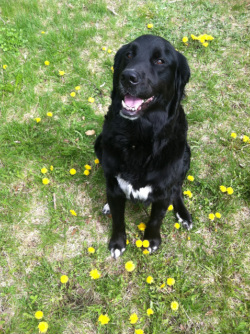share this planet.
Animal-Assisted Therapy

A trained and certified pet therapy animal works alongside its handler or owner in order to improve the level of compassion and stimulation in a client. This process is known as animal-assisted therapy. Barker and Dawson (1998) provide the definition: “Animal assisted therapy (AAT) involves interaction between patients and a trained animal, along with its human owner or handler, with the aim of facilitating patients' progress toward therapeutic goals" (p. 797). Animal-assisted therapy can also be referred to as pet therapy or companion animal therapy, each regarding the same human-animal partnership towards human client healing.
Animal-assisted therapy is considered a supplement to a client’s existing mode of therapy. Chandler (2005) further describes AAT in a professional practice by stating, “A credentialed therapist, working within the scope of a professional practice, sets therapeutic goals, guides the interaction between patient and animal, measures progress toward meeting therapy goal, and evaluates the process” (p. 5). As such, a therapy animal can be incorporated into any style of therapy: direct or indirect, group or individual, and across age groups. The therapy animal’s handler or owner is responsible for proper licensing and certification within their field. A variety of professions and settings encourage the use of animal-assisted therapy. Professions include: nursing, counseling and psychology, physical rehabilitation, therapeutic recreation, and speech therapy (Gammonely et al., 1997). Schools, counseling agencies, hospitals, nursing homes, hospice care, developmental disability facilities, juvenile detention centers, and prisons compromise settings in which AAT may work well (Burch, 2003).
Books:
Animal Assisted Therapy in Counseling by Cynthia K. Chandler
Animal-assisted Interventions for Individuals with Autism by Merope Pavlides and Temple Grandin
The Role of Companion Animals in Counseling and Psychology by Jane K. Wilkes
Handbook on Animal-Assisted Therapy, Third Edition: Theoretical Foundations and Guidelines for Practice by Aubrey H. Fine
Paws & Effect: The Healing Power of Dogs by Sharon R. Sakson
Teaching Empathy: Animal-Assisted Therapy Programs for Children and Families Exposed to Violence by Lynn Loar Ph.D., Libby Colman Ph.D and Barbara W. Boat Ph.D.
The Psychology of the Human-Animal Bond: A Resource for Clinicians and Researchers by Christopher Blazina, Güler Boyra and David Shen-Mille
Journal Articles:
American Kennel Club. (2010). American Canine Good Citizen Program. Retrieved from http://www.akc.org/events/cgc.
Barker, S. B. and Dawson, K. S. (1998). The effects of animal-assisted therapy on anxiety ratings of hospitalized psychiatric patients. Psychiatric Services, 49(6), 797-801.
Gammonley, J., Howie, A. R., Kirwin, S., Zapf, S. A., Frye, J., Freeman, G., & Stuart-Russell, R. (1997). Animal-assisted therapy. Therapeutic Interventions. Renton, WA: Delta Society.
Katcher, A. H. (2000). Animal-assisted therapy and the study of human-animal relationships. Handbook on Animal-Assisted Therapy: Theoretical Foundations and Guidelines for Practice. San Diego: Academic Press.
Lasher, M. (1999). And the Animals Will Teach You. New York: Berkley Trade.
Odendaal, J. S. J. (2000). Animal-assisted therapy- magic or medicine? Journal of Psychosomatic Research, 49(4), 275-280.
Wilson, E. O. (1984). Biophilia. USA: Harvard University Press.
Animal-assisted therapy is considered a supplement to a client’s existing mode of therapy. Chandler (2005) further describes AAT in a professional practice by stating, “A credentialed therapist, working within the scope of a professional practice, sets therapeutic goals, guides the interaction between patient and animal, measures progress toward meeting therapy goal, and evaluates the process” (p. 5). As such, a therapy animal can be incorporated into any style of therapy: direct or indirect, group or individual, and across age groups. The therapy animal’s handler or owner is responsible for proper licensing and certification within their field. A variety of professions and settings encourage the use of animal-assisted therapy. Professions include: nursing, counseling and psychology, physical rehabilitation, therapeutic recreation, and speech therapy (Gammonely et al., 1997). Schools, counseling agencies, hospitals, nursing homes, hospice care, developmental disability facilities, juvenile detention centers, and prisons compromise settings in which AAT may work well (Burch, 2003).
Books:
Animal Assisted Therapy in Counseling by Cynthia K. Chandler
Animal-assisted Interventions for Individuals with Autism by Merope Pavlides and Temple Grandin
The Role of Companion Animals in Counseling and Psychology by Jane K. Wilkes
Handbook on Animal-Assisted Therapy, Third Edition: Theoretical Foundations and Guidelines for Practice by Aubrey H. Fine
Paws & Effect: The Healing Power of Dogs by Sharon R. Sakson
Teaching Empathy: Animal-Assisted Therapy Programs for Children and Families Exposed to Violence by Lynn Loar Ph.D., Libby Colman Ph.D and Barbara W. Boat Ph.D.
The Psychology of the Human-Animal Bond: A Resource for Clinicians and Researchers by Christopher Blazina, Güler Boyra and David Shen-Mille
Journal Articles:
American Kennel Club. (2010). American Canine Good Citizen Program. Retrieved from http://www.akc.org/events/cgc.
Barker, S. B. and Dawson, K. S. (1998). The effects of animal-assisted therapy on anxiety ratings of hospitalized psychiatric patients. Psychiatric Services, 49(6), 797-801.
Gammonley, J., Howie, A. R., Kirwin, S., Zapf, S. A., Frye, J., Freeman, G., & Stuart-Russell, R. (1997). Animal-assisted therapy. Therapeutic Interventions. Renton, WA: Delta Society.
Katcher, A. H. (2000). Animal-assisted therapy and the study of human-animal relationships. Handbook on Animal-Assisted Therapy: Theoretical Foundations and Guidelines for Practice. San Diego: Academic Press.
Lasher, M. (1999). And the Animals Will Teach You. New York: Berkley Trade.
Odendaal, J. S. J. (2000). Animal-assisted therapy- magic or medicine? Journal of Psychosomatic Research, 49(4), 275-280.
Wilson, E. O. (1984). Biophilia. USA: Harvard University Press.
Restoring our Relationship with the Earth

An honest repsect for our environment and the Earth we share has always been a present with us since the beginning of our time. In Western society, it wasn’t until the boom of modernization in the mid nineteenth century that we began to recognize the disconnect we held with the environment. It's been explained that "our ecological peril is largely a crisis of consciousness and culture" (Adams, 2005, p. 270). This is not a case that can be solved with technological advances or modern day logic. This is something that needs to be solved "psychologically and sociologically, via a transformation of consciousness and culture" (Adams, 2005, p. 270). As a society, we’ve convinced ourselves that nature is not alive, it cannot feel, and as a result we don’t need to respect it. Orr (1994) describes these false beliefs best- "to dead matter we owe no obligations" (p. 38). Ecopsychology brings all of these concepts and ideas together, allowing us to heal ourselves through healing nature.
Books:
Collapse by Jared Diamond
Ecopsychology by Gomes and Kanner
Ecopsychology: Restoring the Earth, Healing the Mind by Theodore Roszak
Ishmael by Daniel Quinn
The Last Hours of Ancient Sunlight by Thom Hartmann
Replenishing the Earth: Spiritual Values for Healing ourselves and the world by Wangari Maathai
The Voice of the Earth by Theodore Roszak
Walden by Henry David Thoreau
The Wisdom of Wilderness by Gerald G. May
Journals:
Adams, W. W. (2005). Ecopsychology and phenomenology toward a collaborative engagement. Existential Analysis, 16 (2), 269-282.
Franklin, D. (2006). Inviting the outdoors in. National Wildlife , 44 (4), 12-14.
Gullone, E. (2000). The biophilia hypothesis and life in the 21st century. Journal of Happiness
Kahn, P.H., Severson, R.L., & Ruckert, J. H. (2009). The human relation with nature and technological nature. Current Directions in Psychological Science, 18(1), p. 37-41.
Martin, J. (2009). Back to nature. Therapy Today , 20 (3), 26-28.
McLaughlin, C. (2006). Meditation on the healing power of nature. Retrieved April 2, 2011, from http://www.visionarylead.org/sp/med_nature.htm
Mest, R. A. (2008). Ecopsychology: The transformative power of home. The Humanistic Psychologist , 36 (1), 52-71.
Nelson, R. (1993, Sep. - Oct.). Understanding Eskimo Science. Audobon, 102-109.
Orr, D. W. (1994). The coming biophilia revolution. Earth Island Journal, 9(2), 38-41.
Rowan, C. (2010). Unplug—don't drug: A critical look at the influence of technology on child behavior with an alternative way of responding other than evaluation and drugging. Ethical Human Psychology and Psychiatry, 12(1), 60-68.
Schneider, K. (2011). Toward a humanistic positive psychology. Journal of the Society for Existential Analysis, 22(1), 32-38.
Wynn, M. (1997). Beauty, providence, and the biophilia hypothesis. Heythrop Journal, 38(3), 283-300.
Books:
Collapse by Jared Diamond
Ecopsychology by Gomes and Kanner
Ecopsychology: Restoring the Earth, Healing the Mind by Theodore Roszak
Ishmael by Daniel Quinn
The Last Hours of Ancient Sunlight by Thom Hartmann
Replenishing the Earth: Spiritual Values for Healing ourselves and the world by Wangari Maathai
The Voice of the Earth by Theodore Roszak
Walden by Henry David Thoreau
The Wisdom of Wilderness by Gerald G. May
Journals:
Adams, W. W. (2005). Ecopsychology and phenomenology toward a collaborative engagement. Existential Analysis, 16 (2), 269-282.
Franklin, D. (2006). Inviting the outdoors in. National Wildlife , 44 (4), 12-14.
Gullone, E. (2000). The biophilia hypothesis and life in the 21st century. Journal of Happiness
Kahn, P.H., Severson, R.L., & Ruckert, J. H. (2009). The human relation with nature and technological nature. Current Directions in Psychological Science, 18(1), p. 37-41.
Martin, J. (2009). Back to nature. Therapy Today , 20 (3), 26-28.
McLaughlin, C. (2006). Meditation on the healing power of nature. Retrieved April 2, 2011, from http://www.visionarylead.org/sp/med_nature.htm
Mest, R. A. (2008). Ecopsychology: The transformative power of home. The Humanistic Psychologist , 36 (1), 52-71.
Nelson, R. (1993, Sep. - Oct.). Understanding Eskimo Science. Audobon, 102-109.
Orr, D. W. (1994). The coming biophilia revolution. Earth Island Journal, 9(2), 38-41.
Rowan, C. (2010). Unplug—don't drug: A critical look at the influence of technology on child behavior with an alternative way of responding other than evaluation and drugging. Ethical Human Psychology and Psychiatry, 12(1), 60-68.
Schneider, K. (2011). Toward a humanistic positive psychology. Journal of the Society for Existential Analysis, 22(1), 32-38.
Wynn, M. (1997). Beauty, providence, and the biophilia hypothesis. Heythrop Journal, 38(3), 283-300.
